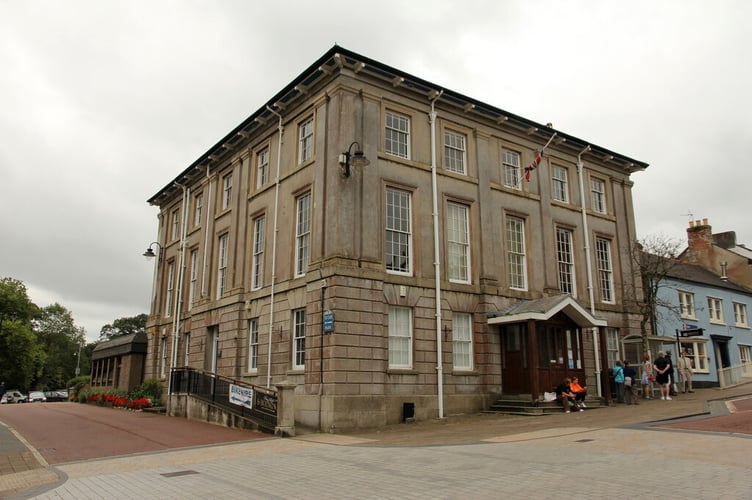A PLAN for Bodmin to become the hub for higher education in North Cornwall has been revealed to Bodmin Town Councillors.
Mark Talbot, the higher education lead for Cornwall Education Learning Trust, also known as CELT, the academy trust which operates Bodmin College and a number of secondary schools across Cornwall, presented the ambitious plans in the full council meeting held on February 22.
The plans come amid a proposed partnership between the school and Bodmin Town Council, which could include plans for higher education courses to be taught at the town council’s historic shire house building on Mount Folly.
Mr Talbot told Bodmin Town Council about a vision that the academy had for its place in the town, where it could be turned into a vibrant place for students to live, learn and contribute towards.
Central to the plan is a proposal for vacant town centre shops to be repurposed to enhance their educational offer, as well as creating space for creative and gallery studios.
One such proposal is that of a ‘Bodmin Creative Studio’, led by Oscar winning film director and producer John Drever, which would be a ‘multi-discipline creative company’ for industry growth in Bodmin, which would serve as an incubator for local creative talent, offering co-working space, grow-on space for graduates and an art fund where members can apply for creative projects.
The college’s higher education offering is set to expand, with the confirmation that Marjon University will be partnering with the college to offer teaching courses, with accessible adult education courses in creative arts and access to higher education also set to be part of the offering in partnership with Adult Education, with the potential to raise the opportunities for the wider community. Also part of CELT’s plans for education in Cornwall includes the creation of two post-16 ‘campuses’ in Cornwall, based at Bodmin College’s sixth-form site and at Newquay Tretherras school.
The academy aims to create a ‘cradle to career’ initiative whereby their educational facilities guide young people from the start of their education to a successful career in Cornwall.
Mr Talbot told councillors about how he envisioned the impact the proposed offering would have on the community of Bodmin.
He compared it to a similar situation when he became a resident of St Mawes in 1996, saying: “There’s so much potential for Bodmin town centre and it is our aim to bring a young, vibrant community to the town centre.
“Outside of my work at the college, I run an art gallery in St Mawes, and when we went there in 1996, it is nothing like it is now.
“Now, demand is so much you can’t get a space for a business there, because people came to St Mawes for the reason that there were galleries and other things evolving, and the people who came brought more things with them.”
Any proposals for the use of the Shire House are dependent on the proposed refurbishment works of the historic building and an agreement with the town council over rental arrangements for the first few years while the course provision is being built up.
Mr Talbot was asked by Councillor Craig Rowe what the next steps would be towards achieving the partnership between Bodmin Town Council and the college.
He responded: “I suppose, ultimately, we are an eleven to eighteen education provider across the CELT organisation so none of the funding received for educating people between those ages can be used for our higher education provision.
“All our courses are solely funded by the student fees paid by students, with all funds being reinvested into giving them the best possible education and paying the people to deliver that. So, to expand our partnership, one thing we would need is an agreement on rental costs, such as a peppercorn rent until it became sustainable, such as over a three-year period.
“Anywhere we go, we are going to struggle to pay extortionate rent until the courses develop and we build student numbers organically.
“We also have to battle against the challenge that people don’t expect there to be degrees available in Bodmin.
“We are an unusual higher education offering as we work with small class sizes in order to be cohesive and promote individual achievement, including people with disabilities and working with those who support individuals with disabilities to maximise the backgrounds our students come from.
“It would be great to work together in that and see how we can mitigate the one big cost which is what rental rates might be?”
However, one thing stressed by Mr Talbot was the element of the community being part of the CELT plans for the town, with the potential for community use of the facilities being brought to the Shire House when not in use for education being part of the proposals offered to Bodmin Town Council.
Councillor Jeremy Cooper called for a three-way memorandum of understanding between CELT, the council and the Bodmin Town Team, the latter of which he claimed was ‘going off on a tangent’ with plans for the centre.
He said that he didn’t wish for the potential of the scheme to be diluted by other ideas he claims are by the town team.
One such idea Cllr Cooper suggested as an example of the town team being ‘on a tangent’ was one where he claimed they ‘suggested the redevelopment of the town’s Ringway Flats’, adding that it ‘detracts from our ability to focus on Bodmin and the regeneration of empty retail space into a more diverse offering’.





Comments
This article has no comments yet. Be the first to leave a comment.